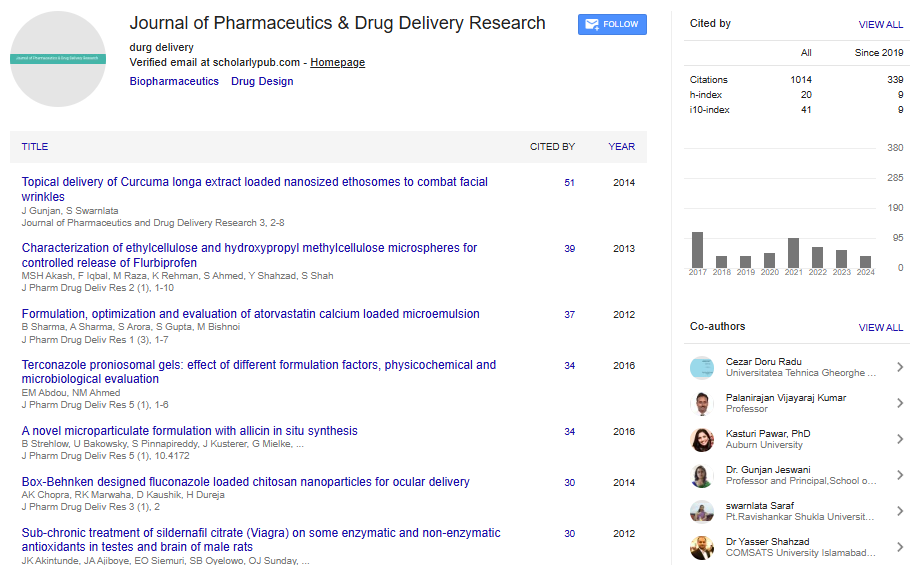Commentary, J Pharm Drug Deliv Res Vol: 13 Issue: 5
Drug Metabolism: Pathways, Phases and Clinical Implications
Anna Brameli*
1Department of Pharmaceutical Science, Tehran University of Medical Sciences, Tehran, Iran
*Corresponding Author: Anna Brameli,
Department of Pharmaceutical Science,
Tehran University of Medical Sciences, Tehran, Iran
E-mail: bramelia28@gmail.com
Received date: 26 August, 2024, Manuscript No. JPDDR-24-151934;
Editor assigned date: 28 August, 2024, PreQC No. JPDDR-24-151934 (PQ);
Reviewed date: 11 September, 2024, QC No. JPDDR-24-151934;
Revised date: 18 September, 2024, Manuscript No. JPDDR-24-151934 (R);
Published date: 26 September, 2024, DOI: 10.4172/2325-9604.1000300
Citation: Brameli A (2024) Drug Metabolism: Pathways, Phases and Clinical Implications. J Pharm Drug Deliv Res 13:5.
Description
Drug metabolism is a vital process in pharmacology that influences the therapeutic effectiveness and safety of medications. Understanding this process helps researchers and healthcare providers optimize drug dosing and predict possible adverse effects. The concept of drug metabolism involves the biochemical modifications that drugs undergo within the body, primarily in the liver, to transform into compounds that can be more easily excreted. This transformation impacts the potency, duration and toxicity of drugs, making it a precarious area of study in pharmacokinetics and pharmacodynamics.
Phases of drug metabolism
Drug metabolism is commonly divided into two primary phases: Phase I and Phase II.
Phase I reactions: Phase I metabolism generally includes oxidation, reduction and hydrolysis reactions. These reactions introduce or expose functional groups on the drug molecule, often catalyzed by enzymes known as Cytochrome P450s (CYPs). CYP enzymes are a large family of proteins found mainly in the liver but also in the intestines, lungs and kidneys. These enzymes help convert lipophilic (fat-soluble) compounds into more polar (water-soluble) metabolites, facilitating the drug’s subsequent excretion. One key point to remember about Phase I is that it doesn’t always lead to drug inactivation; sometimes, it converts drugs into more active forms, known as prodrugs. An example is codeine, which is metabolized into morphine, a far more potent analgesic.
Phase II reactions: Following Phase I, drugs undergo Phase II reactions where conjugation with polar groups like glucuronic acid, sulfate, or glycine occurs, further increasing solubility and aiding excretion. Phase II reactions are catalyzed by enzymes such as uridine diphosphate-glucuronosyltransferases and sulfotransferases. These modifications render the drug molecules more hydrophilic, making them easier to eliminate through renal or biliary excretion. Unlike Phase I, Phase II reactions often result in the inactivation of drugs, preparing them for safe excretion.
Drug metabolism is not a one-size-fits-all process; it can vary significantly between individuals. Genetic differences, known as polymorphisms, affect enzyme activity, leading to classifications of individuals as poor, intermediate, extensive, or ultra-rapid metabolizers. For example, polymorphisms in CYP2D6, a major enzyme involved in drug metabolism, can influence how patients respond to antidepressants, antipsychotics and pain relievers.
Environmental factors, including diet, smoking, alcohol consumption and exposure to other drugs, also affect drug metabolism. Certain foods can inhibit or induce enzymes; for instance, grapefruit juice can inhibit CYP3A4, an enzyme that metabolizes many medications, potentially leading to toxic accumulation of the drug in the body.
Understanding drug metabolism is essential in clinical practice for dose adjustment, predicting drug interactions and preventing adverse effects. Physicians must consider a patient’s metabolic status, possible drug-drug interactions and any relevant genetic information when prescribing medications. For instance, a poor metabolizer may require a lower dose of certain drugs to avoid toxicity, while an ultra-rapid metabolizer may need higher doses for therapeutic efficacy. Additionally, identifying drugs that share metabolic pathways helps avoid harmful interactions. For example, taking two medications metabolized by the same CYP enzyme can lead to competition and higher plasma levels of one or both drugs, increasing the risk of side effects.
Conclusion
Drug metabolism is a complex yet essential component of pharmacology, with direct implications for patient safety and treatment efficacy. Phase I and II reactions, genetic and environmental influences and the clinical implications of metabolic variations highlight the need for a personalized approach to medication management. Future research in pharmacogenetics and personalized medicine will likely offer new insights, allowing healthcare providers to optimize drug therapy based on individual metabolic profiles.
 Spanish
Spanish  Chinese
Chinese  Russian
Russian  German
German  French
French  Japanese
Japanese  Portuguese
Portuguese  Hindi
Hindi 
